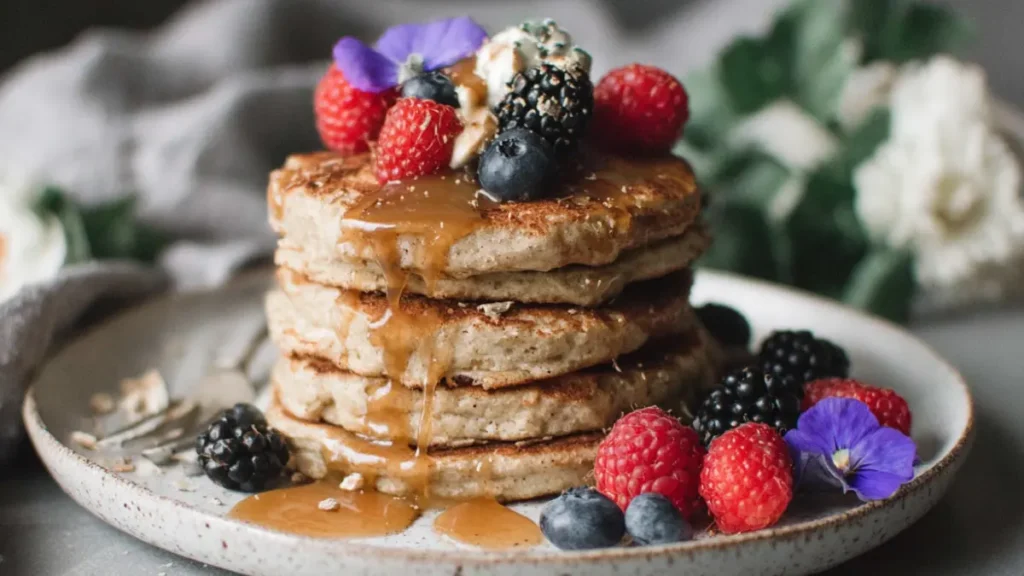If you need a quick breakfast that actually hits your protein target, these high-protein overnight oats are the easiest place to start. They’re creamy, ready in the fridge when you wake up, and built to deliver at least 20 grams of protein per jar. Below you’ll find the base formula, how to make it lighter for weight loss, and how to push it up to 25–45 grams for muscle gain.
This guide covers everything: a base recipe, eight flavor-packed variations, a protein powder comparison, storage tips, and answers to the most common questions people ask about overnight oats. If you want more easy, protein-first breakfast ideas, check this high-protein breakfast guide.
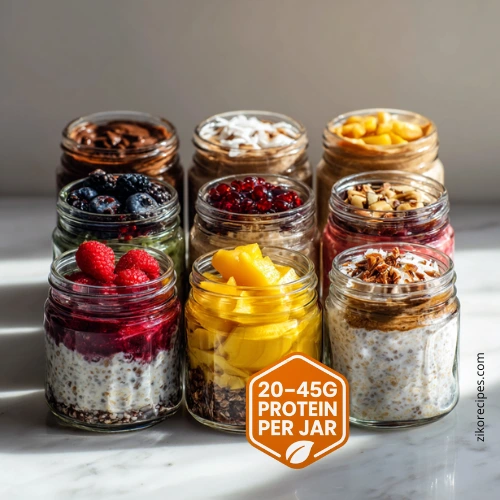
Why These Are High Protein Overnight Oats
High-protein overnight oats should do more than soak oats in milk – this version is designed to hit 20–25 g of protein and actually keep you full until lunch.
What counts as a high protein for breakfast
A breakfast is considered high protein when it gives at least 18–20 g of protein per serving. Classic overnight oats made only with oats and milk stay around 7–10 g, so they don’t keep you full very long and they don’t really support muscle recovery or weight-loss goals. For people searching high protein overnight oats, protein overnight oats for weight loss, or macro friendly overnight oats, we need to push that number higher.
How we reach 20–25 g of protein in these overnight oats
This recipe is built to hit that target. We do it by combining rolled oats for slow carbs, Greek yogurt or skyr for a big protein boost, milk (or high-protein milk), and small add-ins like chia or hemp seeds. Made this way, one jar lands around 20–22 g of protein. If you add 1 scoop of protein powder or increase the yogurt to 3/4 cup, you can reach 25–30 g, which is ideal for muscle gain or higher-protein meal prep breakfasts.
Overnight oats are more than just convenient. They combine protein, fiber, and healthy fats in one balanced jar. This trio works together to keep hunger away for hours and to give steady energy without blood sugar spikes.
- Protein: Greek yogurt, protein powder, or even nut butters help each serving deliver enough protein to support satiety and recovery.
- Fiber: Rolled oats and chia seeds are rich in fiber, including beta glucan, which supports digestion and helps control appetite.
- Healthy fats: Seeds and nut butters add good fats that slow digestion, so you feel satisfied longer.
This balance is what makes these overnight oats actually filling, not just trendy.
Can you make high-protein overnight oats without protein powder
Yes. If you don’t want to use whey or vegan protein powder, keep the Greek yogurt/skyr + high-protein milk + chia or hemp. That keeps you in the 18–22 g range using real food ingredients. Later, if you need a 25–30 g breakfast (for gym days or to match a 25 g protein breakfast plan), just stir in a scoop of protein powder before refrigerating.

Ingredients You Need (Base + Protein Boosters)
These are the core ingredients that make your overnight oats creamy, filling, and protein-packed, with options for dairy, dairy-free, and vegan versions.
Rolled oats for overnight oats
Use old-fashioned rolled oats. They soak well overnight, keep a creamy texture, and give fiber and slow-release carbs. If you need it, choose certified gluten-free oats. Instant oats get mushy and steel-cut oats need more liquid and time.
Protein source (Greek yogurt, skyr, protein powder)
This is where these overnight oats become high protein. You can pick one or combine two:
- Greek yogurt or skyr: 12–15 g of protein plus creaminess.
- High-protein milk (dairy, ultra-filtered, or soy): adds 8–13 g.
- Cottage cheese (blended): great for muscle-gain versions.
- Protein powder (whey or plant-based): easiest way to push to 25–30 g.
Choose the combo that fits your audience: dairy, dairy-free, or vegan protein.
Liquid and texture boosters
- Milk or plant milk: dairy milk, soy milk, or high-protein plant milks give the best protein-to-calorie ratio. Almond or oat milk work too but add less protein.
- Chia seeds: add thickness, omega-3s, and extra fiber.
- Hemp seeds or ground flax: small spoon, but extra protein, healthy fats, and better macros.
These ingredients help control the texture so the oats are not runny the next morning.
Flavor ideas for protein overnight oats (berries, cocoa, nut butter)
To keep it interesting and Pinterest-friendly, rotate flavors:
- Berries or chopped fruit for a weight-loss version
- Cocoa + peanut butter for a higher-calorie, muscle-gain jar
- Vanilla, cinnamon, or maple for classic breakfast oats
- Nuts and seeds for crunch.
Flavorings do not change the base formula, but they help you target more long-tail keywords like high protein overnight oats without protein powder, macro friendly overnight oats, or healthy breakfast recipes for weight loss.
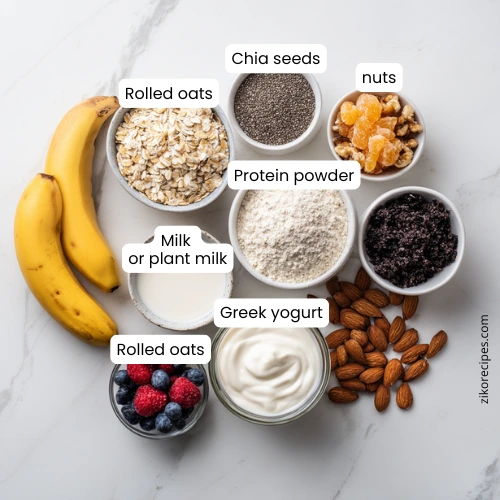
How to Make High-Protein Overnight Oats (Step by Step)
Once you have the base formula, the method is always the same. It takes under 5 minutes, it is no-cook, and the fridge finishes it for you.
Step 1: Mix the high-protein base
In a jar or meal-prep container, combine:
- 1/2 cup rolled oats
- 1/2 cup milk of choice (dairy, soy, or high-protein milk)
- 1/2 cup Greek yogurt or skyr
- 1 tbsp chia seeds
This gives you the right ratio of liquid to oats so the mixture thickens overnight.
Step 2: Add protein boosters
To reach 20–25 g of protein, add one of these:
- 1 scoop protein powder (whey or plant-based), or
- 1 tbsp nut or seed butter, or
- 2–3 extra tbsp Greek yogurt
Stir well so there are no dry pockets of powder.
Step 3: Add flavors
Mix in your add-ins now:
- Fruit (berries, apple, banana)
- Flavor (cocoa, vanilla, cinnamon)
- Texture (nuts, seeds, coconut)
This is where you can make a lighter weight-loss version (berries, no nut butter) or a muscle-gain version (peanut butter, cocoa, dairy milk).
Step 4: Refrigerate overnight
Cover and refrigerate for at least 4 hours, ideally overnight. The oats absorb the liquid, the chia gels, and you get a thick, spoonable breakfast.
Step 5: Stir and serve in the morning
In the morning, stir, add a splash of milk if it’s too thick, and top with berries, nut butter, or seeds. Serve cold, or warm it gently if you prefer. The method stays the same for every flavor.
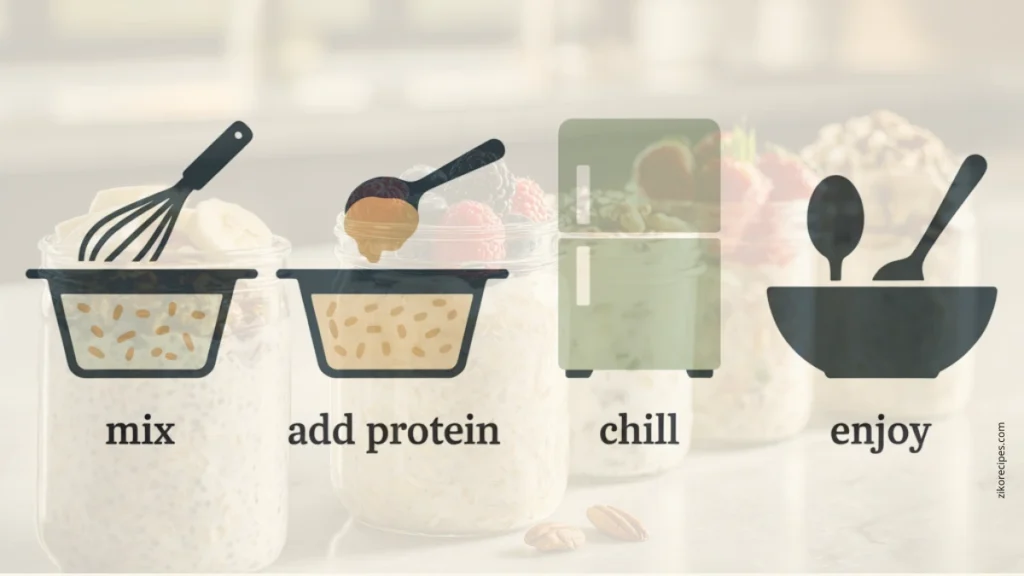
Variations for Your High-Protein Overnight Oats
Whether you want a lighter breakfast for weight loss, a higher-calorie jar for muscle gain, or a dairy-free option, use these variations to match your nutrition goal.
For weight loss high-protein overnight oats (300–350 kcal, 18–20 g protein)
Use unsweetened almond milk or low-fat milk, keep the Greek yogurt, skip nut butter, and add fresh berries. This keeps the jar filling but lighter in calories while still giving 18–20 g of protein, which is what people mean when they search “protein overnight oats for weight loss.”
- 1/2 cup rolled oats
- 1/2 cup Greek yogurt (or skyr)
- 1/2–3/4 cup unsweetened almond milk
- 1 tbsp chia seeds
- 1/2 cup berries
About 300–350 kcal | 18–20 g protein - You can rotate these protein oats with healthy smoothies for busy mornings.
For muscle gain high-protein overnight oats (25–30 g protein, 450–500 kcal)
Use dairy milk or high-protein milk, increase the Greek yogurt to 3/4 cup, and add 1 scoop protein powder or 1 tbsp peanut/almond butter. This matches queries like “overnight oats recipe for muscle gain” and “25 gram protein breakfast.”
- 1/2 cup rolled oats
- 3/4 cup milk (dairy or high-protein)
- 3/4 cup Greek yogurt
- 1 tbsp chia or hemp
- 1 scoop protein powder or 1 tbsp nut butter
About 25–30 g protein | 450–500 kcal - For a higher-protein lunch on the same day, make this roasted veggie grain bowl with 3 sauces.
Dairy-free / no-protein-powder version
Make the base with certified GF oats, soy or pea milk (higher protein than almond), and coconut or almond yogurt. Add 1 tbsp hemp seeds to stay close to 18–20 g protein without whey or casein. This is useful for users searching “overnight oats without protein powder.”
Kid-friendly / sweet breakfast
Use regular milk, vanilla, and berries, skip chia if your kids don’t like the texture, and don’t add protein powder. It’s still balanced but milder in taste.
8 Flavor Variations With Protein Per Serving
Each variation uses the same base recipe from above, with added mix-ins for flavor and extra protein. Protein counts are approximate and depend on the brand of protein powder or yogurt you use.

Protein counts are approximate and assume 1/2 cup Greek yogurt + high-protein milk + 1/2 scoop protein powder. Your numbers may change based on brand.
Chocolate Peanut Butter Banana high-protein oats – ~45g Protein
- ½ scoop chocolate protein powder
- 1 tbsp peanut butter
- ½ banana, sliced
- Optional: cocoa powder for richer flavor
Blueberry Lemon Chia protein oats – ~35g Protein
- ½ scoop vanilla protein powder
- ½ cup blueberries (fresh or frozen)
- 1 tsp lemon zest
- 1 tsp chia seeds
Apple Cinnamon Crunch – ~30g Protein
- ½ scoop vanilla protein powder
- ½ cup diced apple
- ½ tsp cinnamon
- 1 tbsp chopped walnuts
Strawberry Cheesecake – ~40g Protein
- ½ scoop strawberry protein powder
- ½ cup diced strawberries
- 1 tbsp crushed graham cracker (or oat crumble)
- 1 tbsp cream cheese or Greek yogurt
Mango Coconut – ~33g Protein
- ½ scoop vanilla protein powder
- ½ cup diced mango
- 1 tbsp shredded coconut
- 1 tsp chia seeds
Mocha Hazelnut – ~36g Protein
- ½ scoop mocha or chocolate protein powder
- 1 tsp instant coffee granules
- 1 tbsp hazelnut butter
- Optional: cacao nibs on top
Vegan Vanilla Berry protein oats – ~28g Protein
- ½ scoop plant-based vanilla protein powder
- ½ cup mixed berries
- 1 tbsp hemp seeds
- Almond or soy milk base
Cookie Dough protein oats – ~42g Protein
- ½ scoop vanilla protein powder
- 1 tsp almond butter
- 1 tsp mini dark chocolate chips
- Optional: ½ tsp vanilla extract
These variations let you switch flavors daily while sticking to the same easy prep.
Protein Powder Guide For Oats
Choosing the right protein powder makes a big difference in taste and texture. Here’s how the most common types compare:
Whey Protein
- Pros: Creamy texture, high-quality protein, mixes well.
- Cons: Not suitable for lactose-intolerant or vegan diets.
- Best for: Muscle recovery and maximum protein per scoop.
Casein Protein
- Pros: Slow-digesting, keeps you fuller for longer.
- Cons: Thick texture, can clump if not mixed well.
- Best for: Overnight soaking since it thickens oats naturally.
Plant-Based Protein
- Pros: Vegan-friendly, dairy-free, often blended with pea, hemp, or rice protein.
- Cons: Some brands can be gritty or less creamy.
- Best for: Dairy-free, vegan, or anyone with digestive sensitivities.
Budget vs. Clean-Label Picks
- Budget-friendly: Whey concentrate and soy-based powders.
- Clean-label: Minimal ingredient options like grass-fed whey isolate or organic pea protein.
Best Pick by Goal
- For weight loss: Whey isolate or pea protein (low calorie, high protein).
- For muscle gain: Whey concentrate or blends (higher calorie and protein density).
- For family-friendly: Plant-based blends with natural flavors.
Storage and Meal Prep
Overnight oats are built for convenience, but how you store them makes a big difference in freshness and flavor.
How Long They Last
- In the fridge: Up to 5 days in sealed jars.
- In the freezer: Up to 2 months, but avoid delicate fruits like berries (add them after thawing).
Best Containers
- Mason jars or glass meal-prep containers with tight lids.
- Wide-mouth jars make stirring and adding toppings easier.
Batch Prep Tips
- Make 4–5 jars at once on Sunday for a week’s breakfasts.
- Add crunchy toppings (nuts, granola) only before eating to keep them crisp.
- Label jars with flavor names and prep dates for quick grabs.
Can You Freeze Overnight Oats?
Yes – but freeze without fruit or yogurt for the best texture. Thaw overnight in the fridge, then add toppings before serving.
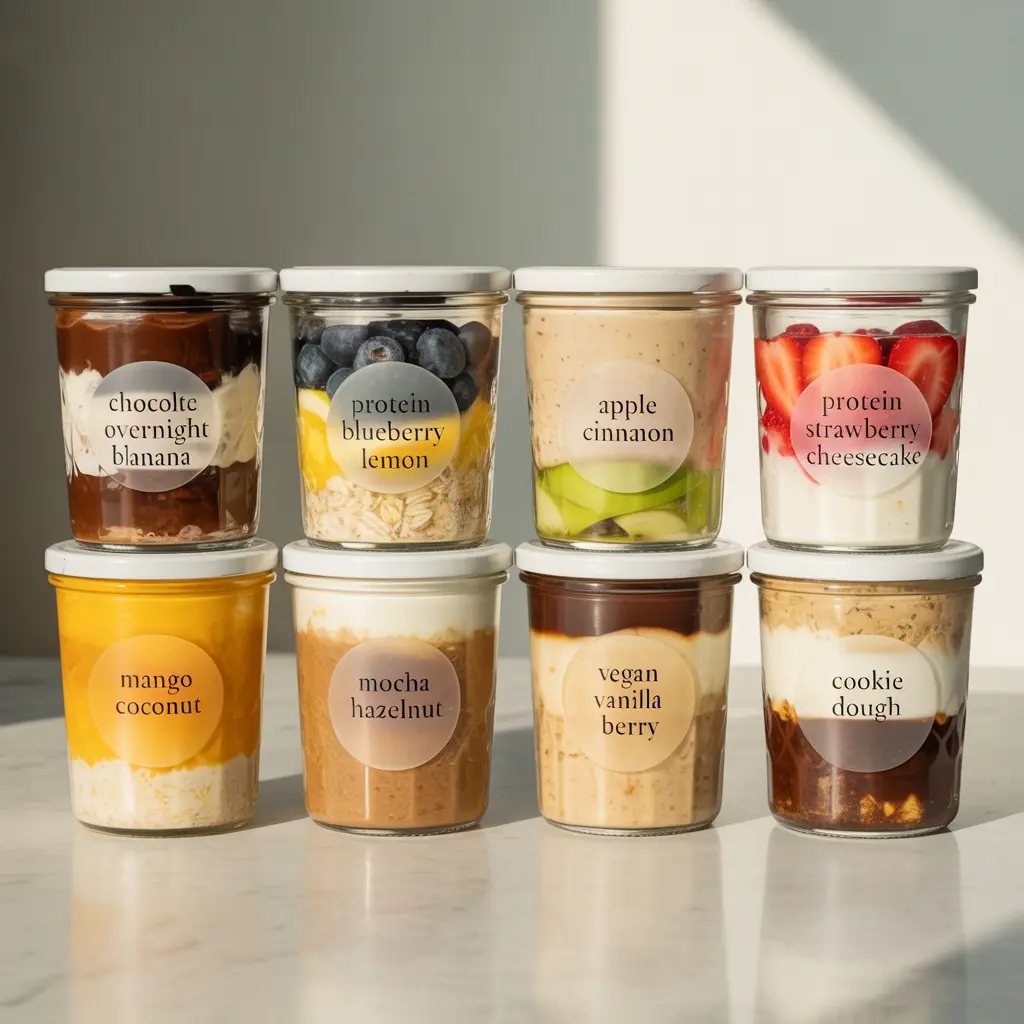
Troubleshooting
Even a simple recipe like overnight oats can have small issues. Here’s how to fix the most common problems.
Too Thick or Too Runny
- Too thick: Add a splash of milk in the morning and stir well.
- Too runny: Use less milk next time or add an extra spoon of chia seeds or yogurt.
Gritty Protein Powder Taste
- Mix protein powder with milk first before adding it to oats.
- Choose a finer, smooth-blending powder (whey isolate or blended plant protein).
Not Sweet Enough
- Natural sweeteners like mashed banana, maple syrup, or honey give gentle sweetness.
- For lower sugar, use flavored protein powder or a few drops of stevia.
Chalky or Bland Flavor
- Add spices (cinnamon, nutmeg, cocoa powder) or flavor extracts (vanilla, almond).
- Mix in fruit purées or nut butter for richer taste.
FAQs About Protein Overnight Oats
Are overnight oats healthy?
Yes. Overnight oats are naturally high in fiber (especially beta glucan from oats), and when you add Greek yogurt, seeds, and a good milk, you get a balanced breakfast with carbs, protein, and healthy fats. That combo helps digestion, keeps you full, and supports steady energy.
How much protein is in these overnight oats?
Made as written (oats + milk + Greek yogurt + chia), one jar gives about 20–22 g of protein. If you add 1 scoop of protein powder or increase the Greek yogurt to 3/4 cup, you can reach 25–30 g.
Can I make high-protein overnight oats without protein powder?
Yes. Use Greek yogurt or skyr, a higher-protein milk (dairy or soy), and 1 tbsp chia or hemp seeds. That keeps you in the 18–22 g range with real food ingredients.
Are high-protein overnight oats good for weight loss?
They can be. Use unsweetened milk, keep the protein high (18–20 g), skip nut butter, and add berries instead of chocolate or sweet toppings. That keeps the jar around 300–350 calories and still filling.
Do overnight oats spike blood sugar?
Not usually. The fiber from oats and chia plus the protein from yogurt slow down digestion, so blood sugar rises more gently. To keep it balanced, avoid too much honey, maple syrup, or sugary toppings.
How long do overnight oats last in the fridge?
Store them in a sealed jar for 3–4 days. If you added fresh fruit on top, eat within 2–3 days for the best texture.
Can I eat overnight oats warm?
Yes. Add a splash of milk and microwave for 30–60 seconds. It will taste like creamy oatmeal, but you still get the protein.
What is the best protein powder for overnight oats?
For a creamy texture, use whey protein or a whey blend. For slower release, use casein. And for dairy-free or vegan, use pea or a good plant-based blend that mixes well.

High-Protein Overnight Oats (Base + Weight Loss + Muscle Gain)
Equipment
- Mason jar or meal prep container
- Mixing spoon
- Measuring cups/spoons
- Optional: blender (for smoother texture or blended oats)
Ingredients
Base (1 Serving)
- ½ cup rolled oats gluten-free if needed
- ½ cup milk dairy, almond, soy, or oat
- 2 tbsp Greek yogurt or plant-based yogurt
- 1 tbsp chia seeds
- 1 scoop 20–25g protein powder (whey, casein, or plant-based)
Optional Boosters
- 1 tbsp nut butter peanut, almond, cashew
- 1 tbsp seeds hemp, flax, pumpkin
- ½ cup fruit banana, berries, mango, apple
- Spices: cinnamon nutmeg, cocoa powder, vanilla extract
- Substitutions: Use soy yogurt for dairy-free pea protein powder for vegan, or add oats soaked in oat milk for a creamier plant-based option.
Instructions
- Mix the base: In a mason jar or container, combine oats, milk, yogurt, chia seeds, and protein powder. Stir until smooth.
- Add boosters: Mix in nut butter, seeds, fruit, or spices to customize flavor and nutrition.
- Chill overnight: Seal the jar and refrigerate for at least 4 hours (preferably overnight).
- Stir and serve: In the morning, stir well and add toppings like fresh berries, nuts, or a drizzle of nut butter.
- Enjoy cold or warm: Eat straight from the fridge, or microwave for 30–60 seconds for a warm version.
Notes
Nutrition Information PROTEIN: 20–25 g (Estimated per Serving – Base Recipe with Whey Protein)
SERVING: 1 jar | CALORIES: 320 kcal | CARBOHYDRATES: 35 g | PROTEIN: 28 g | FAT: 8 g | SATURATED FAT: 2 g | CHOLESTEROL: 25 mg | SODIUM: 140 mg | POTASSIUM: 420 mg | FIBER: 6 g | SUGAR: 6 g | VITAMIN A: 90 IU | VITAMIN C: 1 mg | CALCIUM: 180 mg | IRON: 2 mgEstimated Recipe Cost
- Rolled oats (½ cup): $0.10
- Milk (½ cup): $0.15
- Greek yogurt (2 tbsp): $0.30
- Protein powder (1 scoop): $0.90
- Chia seeds (1 tbsp): $0.15
Cost for 5 Jars (meal prep): ~$8.00
Recipe Notes
- Substitutions: Swap yogurt for dairy-free alternatives; replace whey with pea protein for vegan; use flavored protein powders for variety.
- Storage: Keep sealed in the fridge for up to 5 days. Freeze plain oats (without fruit or yogurt) for up to 2 months.
- Variations: Try flavors like Chocolate Peanut Butter Banana (45g protein), Blueberry Lemon Chia (35g protein), or Vegan Vanilla Berry (28g protein).
- Pro Tips: Mix protein powder with milk first for smoother texture. Add fruit right before eating for freshness.
- Diet: High Protein, Gluten-Free (if using certified oats), Vegetarian, Vegan-friendly (with plant-based swaps).
- To make it 25–30 g protein, add 1 scoop protein powder or extra Greek yogurt.
FAQ within Notes
- Do overnight oats spike blood sugar? No, because protein and fiber slow down digestion.
- Can I eat overnight oats warm? Yes, microwave for 30–60 seconds.
- Best protein powder for overnight oats? Whey isolate for creaminess, casein for thickness, or pea protein for vegan diets.
Call-to-Action (CTA)
Did you love this high protein overnight oats recipe? Share your version in the comments or tag us on social media with your favorite flavor variation. Don’t forget to print the recipe card or save it to Pinterest for later!Looking for more breakfast ideas with at least 20 g of protein? Read the full guide: High-Protein Breakfast (sweet, savory, and meal-prep options)
References
To give you accurate, science-backed information, here are trusted sources that explain the benefits of oats, protein, and balanced breakfasts:
- USDA FoodData Central – Nutritional breakdown of oats, chia seeds, and common protein sources.
- Harvard T.H. Chan School of Public Health – Research on dietary fiber and heart health.
- International Society of Sports Nutrition (ISSN) – Position stand on protein intake for athletes.
- National Institutes of Health (NIH) – Information on omega-3 fatty acids and general nutrition.
Adding references not only builds trust with readers but also signals authority to search engines.
More High Protein Breakfast Ideas
If you love overnight oats, you might enjoy these other quick, protein-packed breakfasts:
- Blueberry Protein Muffins
- 3-Ingredient Banana Muffins
- Protein Bagels
- Baked Cottage Cheese Eggs
- Gluten-Free Dairy-Free Breakfast
These ideas can be rotated with overnight oats to keep your mornings interesting while hitting your protein goals.

Final Thoughts
High protein overnight oats are simple, customizable, and ideal for busy mornings. With endless flavor options, a balanced mix of protein, fiber, and healthy fats, and the ability to prep days in advance, they’re one of the easiest ways to start your day feeling full and energized.
Whether your goal is weight loss, muscle recovery, or just a healthier breakfast routine, these recipes give you the flexibility to match your needs while keeping things quick and delicious.
Try It This Week
Pick one flavor variation, prep a few jars tonight, and wake up tomorrow with breakfast ready to go. Once you find your favorite mix, share it in the comments below – I’d love to know which recipe you’ll try first.

